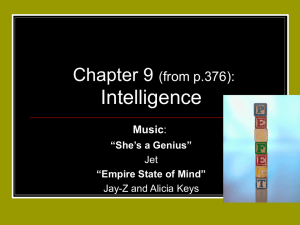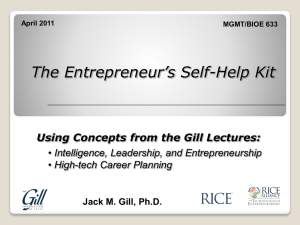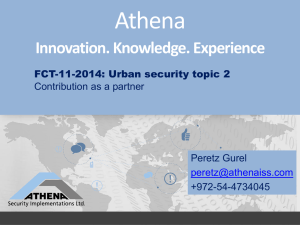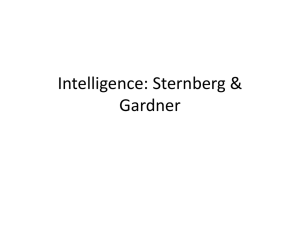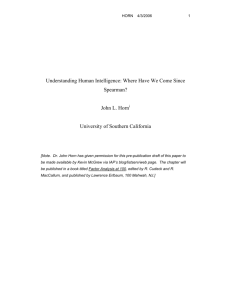Mental_Abilities
advertisement
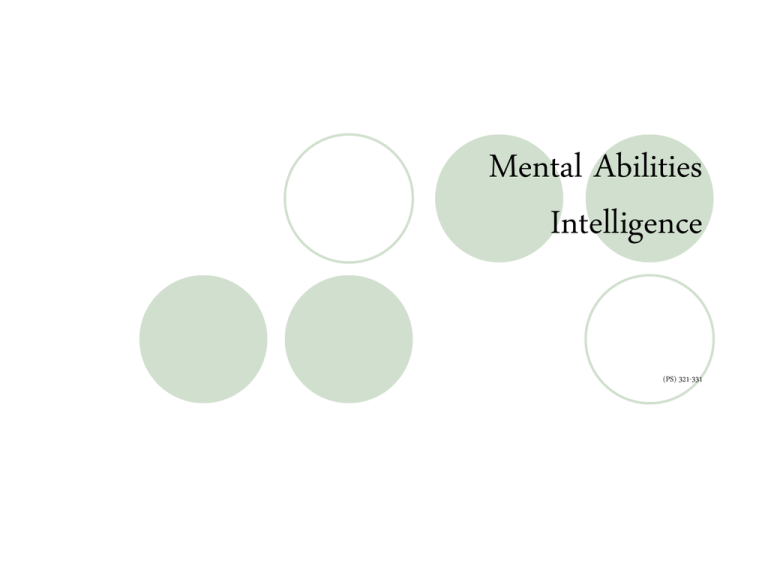
Mental Abilities Intelligence (PS) 321-331 1. Psychometric approach 2. Information processing approach Intelligence 3. Triarchal approach 4. Multiple Intelligences approach 5. Ecological approach Psychometric approach It analyzes people’s responses to questions and tasks in order to describe the structure of intelligence. Spearman: noted that scores on almost all tests of mental abilities were positively correlated. People who did well on one test also tended to do well on all of the others. He concluded that these correlations were created by general mental ability, which he called “g”, for general intelligence, and a group of special intelligences, which he collectively referred to as “s”. The “s” factors are the specific information and skills needed for particular tasks. The correlations that could not be by either “g” or “s” were called group factors. L.L.Thurstone: he criticized Spearman’s mathematical methods. He analyzed the correlations among IQ tests to identify the underlying actors, or abilities, beaing measured by those tests with a statistical technique called factor analysis. He found seven relatively independent primary mental abilities, which he labeled as numerical ability, reasoning, verbal fluency, spatial visualization, perceptual ability, emory, and verbal comprehension. He didn’t deny that “g” exists, but he argued that it’s not as important as primary mental abilities in discribing a particular person. Raymond B. Cattell: he agreed with Spearman, but suggested that there are two kinds of “g”, which he labeled: fluid and crystallized. Fluid intelligence: the basic power of reasoning and problem solving. It allows us to think critically about assertions and understand relationships between concepts. Crystallized intelligence: it involves specific knowledge gained as a result of applying fluid intelligence. Who is right? Most psychologists today agree that there is a positive correlation between several tests of mental ability, a correlation that is due to a factor known as “g”. The brain probably does not “contain” some unified “thing” corresponding to what people call intelligence; “g” is more likely a collection of subskills and mental abilities, many of which are needed to suceed on any test of intelligence. Information-processing approach It analyzes the process of intelligent behavior, not test answers and other products of intelligence. This approach relates the basic mental processes of perception, memory, and thought to the concept of intelligence. Earl Hunt: suggested that intelligent behavior depends on the amount of attention that we can mobilize. He suggested that people with a greater intellectual ability have more attentional resources available. Jensen & Vernon: thought that perhaps intelligent people have “faster brains” than other people and carry out mental processes more quickly. When a task is complex, having a “fast brain” might decrease the chance that information will disappear from memory before it can be used. Hans Eynseck: proposed that intelligence can be defined as the error-free transmission of information through the brain. Triarchal Theory According to Sternberg, a complete theory must deal with three aspects of intelligence: Internal components (or processes): • Performance components: processes such as perceiving stimuli, holding information in STM and calculating sums and differences • Knowledge-acquisition components: they involve the selective application of the processes used in gaining and storing new information • Metacomponents: they control the performance and knowledge-acquisition components; they are involved in organizing and setting up a problem. Relation of the internal components: it amounts to the ability to profit from experience by altering how the components are applied. External effects: adapting or shaping environments. It means being intelligent in areas that psychology doesnt examine; in everyday life. Multiple Intelligences Howard Garnder supported the idea that cases of remarkable ability in specific areas constitute an evidence of the existence of multiple intelligences. He looked not just at test scores and information-processing experiments but also at the ways in which children develop, at the exceptional abilities of child prodigies and remarkable adults, at biological research, and at the values and traditions of various cultures. According to Gardner, all people possess a numberof intellectual potentials or “intelligences”, each of which involves a set of skills that allows them to solve problems. Biology provides raw capacities to each of these intelligences; cultures provide symbolic systems such as language to mobilize the raw capacities. The specific intelligences that Gardner proposes are: Linguistic Logical-mathematical Spatial Musical Body-kinesthethic Personal Intrapersonal Naturalist Existentialist Ecological Approach The ecological approach to intelligence views intelligence as mental activity that allows people to select, shape, and adapt to those aspects of the environment most relevant to their lives. The ecological approach suggests that intelligence is not the same in all environments. Mental abilities & thinking Creativity Unusual mental abilities -Giftedness -Mental retardation -Learning disabilities




